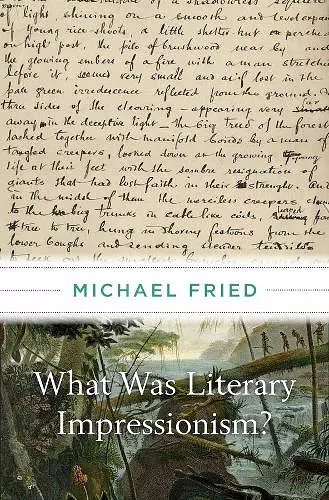What Was Literary Impressionism?
Format:Hardback
Publisher:Harvard University Press
Published:27th Apr '18
Currently unavailable, and unfortunately no date known when it will be back

“My task which I am trying to achieve is, by the power of the written word, to make you hear, to make you feel—it is, before all, to make you see. That—and no more, and it is every-thing.” So wrote Joseph Conrad in the best-known account of literary impressionism, the late nineteenth- and early twentieth-century movement featuring narratives that paint pictures in readers’ minds. If literary impressionism is anything, it is the project to turn prose into vision.
But vision of what? Michael Fried demonstrates that the impressionists sought to compel readers not only to see what was described and narrated but also to see writing itself. Fried reads Conrad, Stephen Crane, Frank Norris, W. H. Hudson, Ford Madox Ford, H. G. Wells, Jack London, Rudyard Kipling, Erskine Childers, R. B. Cunninghame Graham, and Edgar Rice Burroughs as avatars of the scene of writing. The upward-facing page, pen and ink, the look of written script, and the act of inscription are central to their work. These authors confront us with the sheer materiality of writing, albeit disguised and displaced so as to allow their narratives to proceed to their ostensible ends.
What Was Literary Impressionism? radically reframes a large body of important writing. One of the major art historians and art critics of his generation, Fried turns to the novel and produces a rare work of insight and erudition that transforms our understanding of some of the most challenging fiction in the English language.
An original and striking interpretation of the turn-of-the-century literary milieu. -- Paul Franz * DH Lawrence Review *
In this book, Michael Fried has given us the best account of the relation of literary writing to its material basis in ink, paper, print, and corporeal movement. What Was Literary Impressionism? transforms our sense of a vital literary tradition and provides revelatory new readings of key texts by writers including Frank Norris, Joseph Conrad, H. G. Wells, and many others. This is a major book by one of the most powerful and influential critical minds of our time. -- Michael Clune, Case Western Reserve University
Michael Fried subtly traces in varied detail a recurring scene in Anglo-American fiction of the turn of the nineteenth century. The display and occlusion of this scene—the scene of writing itself—is the ‘project’ and the ‘problematic’ of literary impressionism: modern but not modernist. The modernists, we may believe, foregrounded language, and even print, but they did not worry about the physical act of writing as the impressionists did. Fried hopes his book may ‘somewhat transform the terms’ of our understanding of a specific literary moment. It will do more than that. It will, if we let it, revise and enrich that understanding to an almost unimaginable degree. -- Michael Wood, Princeton University
ISBN: 9780674980792
Dimensions: unknown
Weight: unknown
400 pages